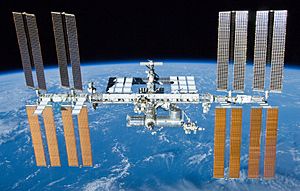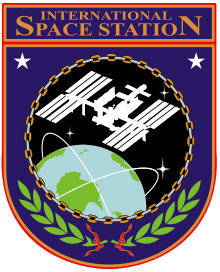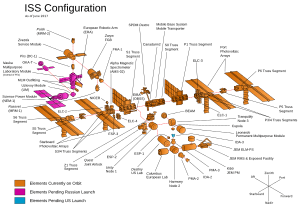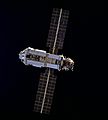International Space Station facts for kids

The International Space Station on 23 May 2010 as seen from STS-132
|
|
 |
|
| Station statistics | |
|---|---|
| COSPAR ID | 1998-067A |
| SATCAT № | 25544 |
| Call sign | Alpha, Station |
| Crew | Fully crewed: 6 Currently aboard: 3 (Expedition 60) |
| Launch | 20 November 1998 |
| Launch pad | |
| Mass | ≈ 419,725 kg (925,335 lb) |
| Length | 72.8 m (239 ft) |
| Width | 108.5 m (356 ft) |
| Height | ≈ 20 m (66 ft) nadir–zenith, arrays forward–aft (27 November 2009) |
| Pressurised volume | 931.57 m3 (32,898 cu ft) (28 May 2016) |
| Atmospheric pressure | 101.3 kPa (29.9 inHg; 1.0 atm) |
| Perigee | 408 km (253.5 mi) AMSL |
| Apogee | 410 km (254.8 mi) AMSL |
| Orbital inclination | 51.64° |
| Orbital speed | 7.66 km/s (27,600 km/h; 17,100 mph) |
| Orbital period | 92.68 minutes |
| Orbits per day | 15.54 |
| Orbit epoch | 14 May 2019 13:09:29 UTC |
| Days in orbit | 27 years, 1 month, 25 days (14 January 2026) |
| Days occupied | 25 years, 2 months, 12 days (14 January 2026) |
| No. of orbits | 116,178 as of May 2019[update] |
| Orbital decay | 2 km/month |
| Statistics as of 9 March 2011 (unless noted otherwise) |
|
| Configuration | |

Station elements as of June 2017[update]
|
|
The International Space Station (ISS) is a huge space station. It is like a very large satellite where people can live for many months. The ISS orbits around Earth in Low Earth orbit. It was built piece by piece, starting in 1998. The station is a team effort involving several countries. These include the United States, Russia, Europe, Japan, and Canada. Other nations like Brazil, Italy, and China also help with the ISS.
Contents
How the ISS Began
In the early 1980s, NASA (the U.S. space agency) planned a space station called Space Station Freedom. This was meant to be like the Soviet Salyut and Mir space stations. But it was never built.
After the Cold War ended, the U.S. decided to work with other countries. In the early 1990s, they talked with Europe, Russia, Japan, and Canada. Their goal was to build a truly international space station. This new project was announced in 1993 and was first called Space Station Alpha. It combined ideas from different space agencies.
Building the ISS Parts
The parts of the ISS were made in many factories around the world. These parts were then sent to the Space Station Processing Facility in Florida, USA. Here, they were put together and prepared for launch. The station's parts are made from strong materials. These include stainless steel, titanium, aluminum, and copper.
Assembling the Station in Space
Building the International Space Station in space was a huge task. Russian parts were launched by their own rockets and then connected. All other parts were carried into space by the Space Shuttle. By 2011, astronauts had spent over 1,000 hours working in space to add 159 parts. Many parts were tested on Earth first. This helped fix problems before they were launched into space.
The first part, called Zarya, was launched in November 1998. It was sent into orbit by a Russian Proton rocket. Two more parts, the Unity Module and Zvezda, were added next. After that, the first crew, called Expedition 1, arrived. Expedition 1 docked with the ISS on November 1, 2000. The crew included U.S. astronaut William Shepherd and two Russian cosmonauts, Yuri Gidzenko and Sergey Krikalev.
Life in Space
Living on the space station is very different from life on Earth. Astronauts have to get used to many changes.
Bedtime in Orbit
The ISS orbits Earth every 90 minutes. This means the sun appears to rise and set 16 times a day! This can make it hard to know when to sleep. Astronauts try to stick to a 24-hour schedule. At bedtime, they sleep in special sleeping bags. These bags are attached to the wall. Astronauts must strap themselves in so they don't float away while sleeping.
Living in Zero Gravity
In orbit, there is no G-Force. This is also called free fall or zero gravity. To help astronauts get ready, trainers put them in water. Floating in water is a bit like having no gravity. But in water, you can push to move. In zero gravity, there's nothing to push against, so you just float. Another way to train is by flying in a plane that drops very fast. This gives a short feeling of zero gravity. This training can make people feel sick at first.
In zero gravity, astronauts don't use their legs much. So, they need to exercise a lot to keep their leg muscles strong. Without gravity, astronauts can get big upper bodies and thin legs. This is sometimes called "chicken-leg syndrome." Astronauts must exercise hard every day to stay healthy.
Eating in space is also tricky. Water and other liquids don't flow downwards in space. If a drink spills, it would float everywhere. Liquids can damage electronic equipment. So, astronauts must be very careful. They drink by sucking water from a bag or a tube. They can't use plates for food because it would float off. Instead, they eat from pouches. Their food is usually dried. This is because crumbs can also harm equipment. Sometimes fresh fruits and vegetables are sent up. But sending them is very expensive and difficult. So, astronauts bring most of their food with them.
Bathroom in Space
On the space station, the "bathroom" is more like a "restroom." You can't really take baths there. Instead, astronauts use squirt guns to "shower." One person squirts water on themselves. Others stand by with a water vacuum to catch any water that floats away. This is quite hard. So, astronauts often just take a "sponge bath" with a wet cloth.
Toilets are another challenge. On Earth, toilets use gravity to flush. Water goes down when you flush. Since there's no gravity on the ISS, the toilet must be attached to the astronauts. It gently sucks away all their waste.
Images for kids
-
A comparison between the combustion of a candle on Earth (left) and in a free fall environment, such as that found on the ISS (right)
-
Original Jules Verne manuscripts displayed by crew inside the Jules Verne ATV
-
Zarya as seen by Space Shuttle Endeavour during STS-88
-
The communications systems used by the ISS * Luch and the Space Shuttle are not in use as of 2020
-
Space Shuttle Endeavour, ATV-2, Soyuz TMA-21, and Progress M-10M docked to the ISS, as seen from the departing Soyuz TMA-20
-
While anchored on the end of the OBSS during STS-120, astronaut Scott Parazynski performs makeshift repairs to a US solar array that damaged itself when unfolding.
-
Mike Hopkins during a spacewalk
-
Engineer Gregory Chamitoff peering out of a window
-
STS-122 mission specialists working on robotic equipment in the US lab
-
The crews of Expedition 20 and STS-127 enjoy a meal inside Unity.
-
The ISS exterior and steelwork taken on 8 November 2021, from the departing SpaceX Crew-2 capsule.
See also
 In Spanish: Estación Espacial Internacional para niños
In Spanish: Estación Espacial Internacional para niños















































